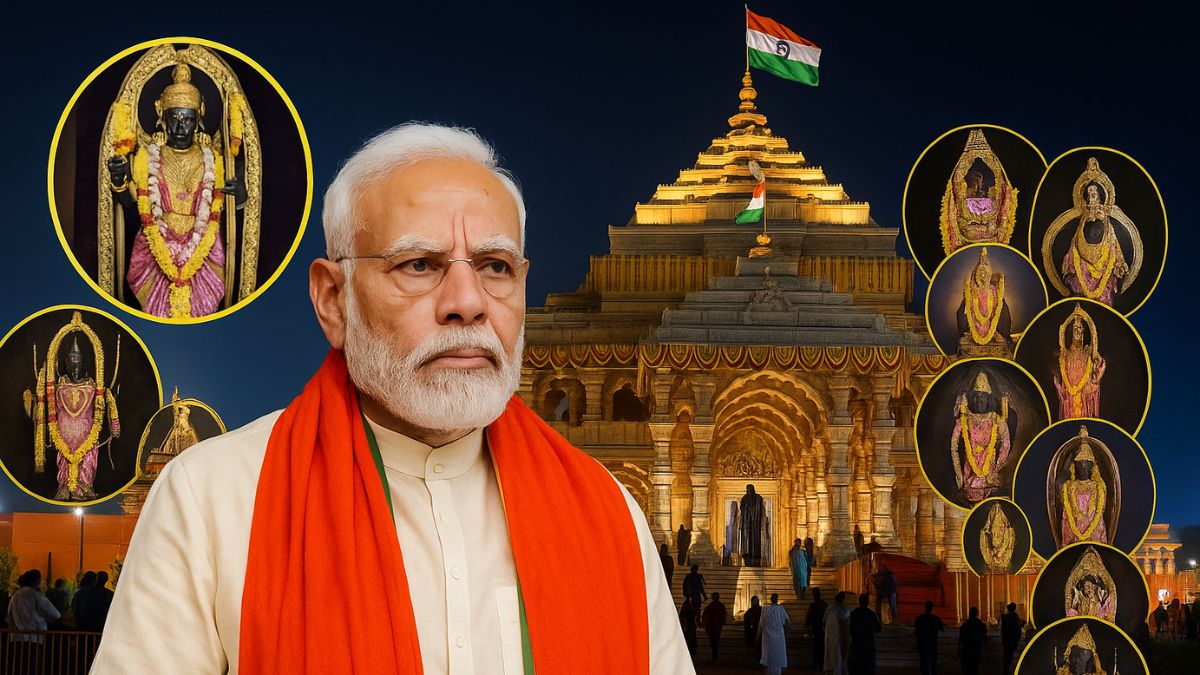Ayodhya, November 17 — The Ayodhya flag-hoisting ceremony, scheduled for November 25 at the newly built Ram Temple complex, is being positioned by the Uttar Pradesh government as a transformational cultural and economic milestone for the region. Officials say the large-scale dhwaj hoisting event, expected to draw lakhs of visitors, could accelerate Ayodhya’s emergence as a global spiritual destination and trigger a long-term tourism boom across the state.
Senior government functionaries describe the ceremony as more than a symbolic religious observance. They see it as the beginning of a broader growth cycle — one that ties cultural revival to economic development, job creation and the expansion of local enterprise. The government is also projecting that the event will bolster hospitality, transportation, crafts and youth-employment initiatives linked to the One District One Product (ODOP) programme.
A Landmark Cultural Event With Economic Weight
The November 25 ceremony will involve the formal hoisting of the temple’s primary dhwaj (flag) atop the Ram Mandir, a ritual intended to mark the completion of key construction elements and the onset of a new religious calendar for the holy city.
While the spiritual significance is clear, officials highlight the economic undercurrents driving preparations. The state expects an enormous influx of pilgrims, domestic tourists and international visitors — many arriving for the first time since the temple’s inauguration.
Tourism and hospitality analysts say Ayodhya has already witnessed record footfall since early 2024, but the flag-hoisting event could create the single biggest tourist surge the city has seen. From hotel occupancy to local transport, food markets, and artisanal crafts, nearly every segment of the city’s economy is expected to receive an immediate boost.
“Ayodhya is on course to become one of India’s top tourism destinations, and the flag-hoisting ceremony will accelerate that trajectory dramatically,” said a senior official associated with the Tourism Department.
Government Preparing for a Massive Visitor Wave
To manage expected crowds, the Uttar Pradesh government is setting up additional monitoring systems, deploying expanded security teams, and coordinating with civic authorities to streamline movement across the city. Temporary shelters, dedicated resting zones, queue-management systems and help desks for first-time visitors are being established.
Transport officials say Ayodhya’s integrated airport, recently operational, will serve as a major entry point for high-volume tourist movement. Railways are preparing for an anticipated surge in bookings, and private interstate bus operators have already reported increased enquiries for the November 23–28 window.
New parking zones, shuttle services, and traffic diversions around the Ram Path and Janmabhoomi Path areas have also been announced.
Tourism Boom Expected Across UP, Not Just Ayodhya
While Ayodhya is the centrepiece of the upcoming ceremony, the state government is positioning the event as part of a larger tourism push across Uttar Pradesh.
Officials expect significant spillover tourism to other major religious and historical circuits, including:
- Kashi Vishwanath Corridor (Varanasi)
- Mathura–Vrindavan pilgrimage sites
- Prayagraj Triveni Sangam
- Chitrakoot Ramayan circuit locations
Travel agencies across the state have already begun offering bundled pilgrimage packages that combine Ayodhya’s flag-hoisting ceremony with multi-city tours.
According to estimates from the state’s Tourism Department, Uttar Pradesh could see tourism revenue growth of 18–22% over the November–February period due to the Ayodhya event and peak travel season overlap.
Jobs, Youth Participation and Local Enterprise Gains
One of the government’s biggest expectations from the Ayodhya flag-hoisting ceremony is its ability to generate employment and local entrepreneurial opportunities.
Key areas expected to benefit:
- Hospitality: Already hiring additional staff for hotels, homestays and guest houses.
- Transport: Auto-rickshaw drivers, taxi operators, e-rickshaw providers, and tour guides.
- Local artisans: ODOP-backed products like Ayodhya’s famous wooden toys, brassware and handcrafted items expected to see a spike in sales.
- Food vendors and restaurants: Demand is likely to outstrip supply for at least a week around the event.
- Logistics & support services: Event management, sound, lighting and cultural programming teams.
“We are expecting a historic rise in footfall. This translates into direct and indirect jobs for thousands of young people,” said a senior UP government spokesperson.
Ayodhya’s Infrastructure Ready for the Global Stage
Ayodhya has undergone a major infrastructural overhaul in the past three years, including:
- Expansion of Ram Path and Dharam Path
- New multi-level parking facilities
- State-of-the-art LED lighting across major roads
- The newly inaugurated Maharishi Valmiki International Airport
- Modernised ghats and riverfront development
These upgrades were timed to coincide with major temple milestones, and officials say the city is fully prepared for global tourism.
Cultural Diplomacy and International Interest
Indian diaspora groups in the US, UK, Canada, Mauritius, and Southeast Asia have expressed interest in organising parallel celebrations on November 25.
Several international journalists and documentary filmmakers have sought special accreditation, signalling global media attention towards the event.
This international interest upscales Ayodhya’s position from a domestic pilgrimage site to a potential global cultural landmark.
Political and Social Dimensions
The event also carries political significance, with Uttar Pradesh positioning itself as a cultural powerhouse and a model for heritage-based development.
Opposition parties have urged that the event should remain “non-political” and inclusive, emphasising the importance of preserving Ayodhya’s communal harmony.
Social groups have requested strict crowd-control measures to ensure safety and minimal disruption for local residents during the high-traffic period.
Conclusion
The Ayodhya flag-hoisting ceremony is shaping up to be more than a spiritual event — it is poised to reshape the city’s economic, cultural and tourism landscape. With massive crowds expected, businesses preparing for record sales, and the state government projecting long-term gains, Ayodhya is on the verge of transforming into one of India’s most significant tourism powerhouses.
Whether this momentum sustains into the next year will depend on continued infrastructure development, balanced crowd management, and strategic policy follow-through. But for now, all eyes are on November 25 — a date that may mark Ayodhya’s next major leap.


























